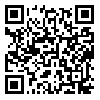Volume 14, Issue 4 (Winter 2020)
jmed 2020, 14(4): 232-244 |
Back to browse issues page
Download citation:
BibTeX | RIS | EndNote | Medlars | ProCite | Reference Manager | RefWorks
Send citation to:



BibTeX | RIS | EndNote | Medlars | ProCite | Reference Manager | RefWorks
Send citation to:
Rasouli B, Aliabadi K, Pourrosstai Aradkani S, Ahmady S, Asgari M. Determining Components of Medical Instructional Design based on Virtual Reality by Research Synthesis. jmed 2020; 14 (4) :232-244
URL: http://jmed.ssu.ac.ir/article-1-1063-en.html
URL: http://jmed.ssu.ac.ir/article-1-1063-en.html
Behnam Rasouli 

 , Khadijeh Aliabadi *
, Khadijeh Aliabadi * 

 , Saied Pourrosstai Aradkani
, Saied Pourrosstai Aradkani 

 , Soleiman Ahmady
, Soleiman Ahmady 

 , Mohammad Asgari
, Mohammad Asgari 




 , Khadijeh Aliabadi *
, Khadijeh Aliabadi * 

 , Saied Pourrosstai Aradkani
, Saied Pourrosstai Aradkani 

 , Soleiman Ahmady
, Soleiman Ahmady 

 , Mohammad Asgari
, Mohammad Asgari 


Department of Educational Technology, Faculty of Psychology and Education, Allameh Tabataba'i University, Tehran, Iran , aliabadikh1345@gmail.com
Abstract: (4789 Views)
Introduction: The purpose of the present study was to determine the components of medical education design based on virtual reality by research synthesis method.
Methods: In the present study a synthesis method was used. In order to study the research background and to collect appropriate data among the databases of Science Direct, Springer, Scopus, ProQuest and Eric (ERIC) search. With the keywords of Educational Design, Virtual Reality, Medical Education, Augmented Reality, Research Synthesis identified from 150 external research cases (English language) between 2006 and 2019 and finally 20 of them with the most coordination and proportion were selected for evaluation.
Result: By reviewing articles and themes analysis, medical education design has five main components that are as follows: 1- Analytical component including determining educational needs, defining learner characteristics, defining theoretical framework, defining characteristics of virtual reality technology, forming a corporate team. Designer, conduct feasibility study and determine the type of content suitable for presentation through virtual reality. Design component includes defining general goals, targeting goals that are achievable by virtual reality, defining features of a virtual reality-based learning environment (free routing, first-person, third-person vision), determining the type of interaction (visual, photo, touch). Virtual and immersion, defining educational strategies (small and large), determining the level of reality, determining the content and organizing it (navigation) 3. Component of production and production including: scenario design, user interface design, content design, design Avatar, Training Agent Design, Virtual Reality Modeling, Platform Development (Hardware and Software) 4. Support and Implementation including Training Implementation, System Integration Virtual education in curriculum, support (technical and educational) 5. Evaluation component including formative evaluation, aggregate evaluation, ease of use evaluation, small group evaluation, large group evaluation, virtual reality based learning environment and platform evaluation (software and hardware).
Conclusion: With respect to that the components of medical education design based on virtual reality have been identified, it is recommended that the medical education process be organized according to the components of educational design and that educational principles and processes be designed according to the capacity of virtual reality technology.
Keywords: Instructional model, Medical education, Virtual reality, Research Synthesis
Methods: In the present study a synthesis method was used. In order to study the research background and to collect appropriate data among the databases of Science Direct, Springer, Scopus, ProQuest and Eric (ERIC) search. With the keywords of Educational Design, Virtual Reality, Medical Education, Augmented Reality, Research Synthesis identified from 150 external research cases (English language) between 2006 and 2019 and finally 20 of them with the most coordination and proportion were selected for evaluation.
Result: By reviewing articles and themes analysis, medical education design has five main components that are as follows: 1- Analytical component including determining educational needs, defining learner characteristics, defining theoretical framework, defining characteristics of virtual reality technology, forming a corporate team. Designer, conduct feasibility study and determine the type of content suitable for presentation through virtual reality. Design component includes defining general goals, targeting goals that are achievable by virtual reality, defining features of a virtual reality-based learning environment (free routing, first-person, third-person vision), determining the type of interaction (visual, photo, touch). Virtual and immersion, defining educational strategies (small and large), determining the level of reality, determining the content and organizing it (navigation) 3. Component of production and production including: scenario design, user interface design, content design, design Avatar, Training Agent Design, Virtual Reality Modeling, Platform Development (Hardware and Software) 4. Support and Implementation including Training Implementation, System Integration Virtual education in curriculum, support (technical and educational) 5. Evaluation component including formative evaluation, aggregate evaluation, ease of use evaluation, small group evaluation, large group evaluation, virtual reality based learning environment and platform evaluation (software and hardware).
Conclusion: With respect to that the components of medical education design based on virtual reality have been identified, it is recommended that the medical education process be organized according to the components of educational design and that educational principles and processes be designed according to the capacity of virtual reality technology.
Keywords: Instructional model, Medical education, Virtual reality, Research Synthesis
Type of Study: Research |
Subject:
Medical Education
Received: 2019/09/27 | Accepted: 2019/11/16 | Published: 2020/03/15
Received: 2019/09/27 | Accepted: 2019/11/16 | Published: 2020/03/15
Send email to the article author
| Rights and permissions | |
 |
This work is licensed under a Creative Commons Attribution-NonCommercial 4.0 International License. |




